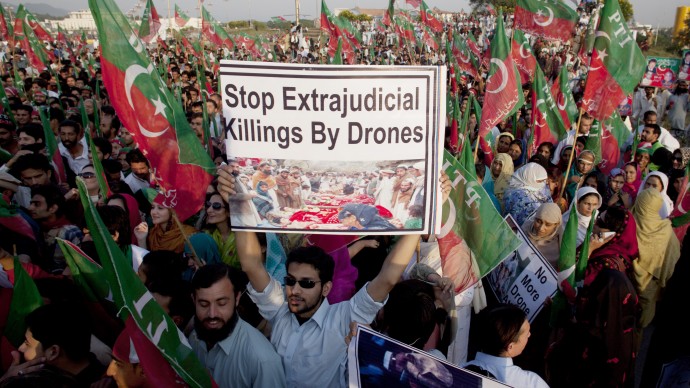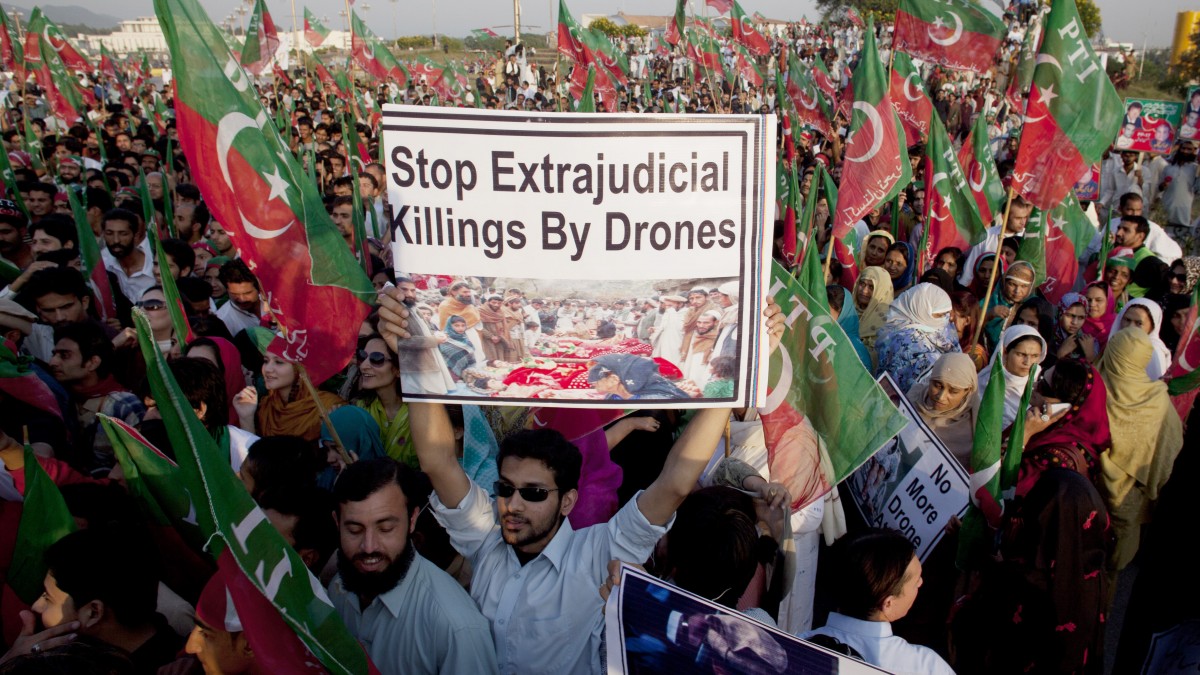
A drone strike in the early hours of Wednesday morning was the bloodiest since October 2012, bucking a recent trend for falling numbers of deaths in each attack.
Multiple drones attacked a vehicle and building in Miranshah, one of the main towns in North Waziristan, in Pakistan’s tribal northwest.
“I never heard such a huge drone strike before. They simultaneously fired four huge missiles and jolted the entire town,” local Nasrullah Khan told NBC reporter Mushtaq Yusufzai. Although initial reports suggested between two and four people were killed, the death toll later rose to 16-18, with up to five others injured.
Following the strike the Pakistan Foreign Ministry issued a statement ‘strongly’ condemning the strike as a ‘violation of Pakistan’s sovereignty.’ The government issues such statements after almost every strike.
The strike’s high death toll is in sharp contrast to recent attacks. The Bureau of Investigative Journalism’s six-monthly report, published on Monday, highlighted that in the first half of 2013, each drone strike killed an average of 3.9 people – down from an average of 11.4 casualties per strike in the same period of 2010.
The last strike to kill so many people hit the border of Orakzai Agency and North Waziristan on October 11 2012, reportedly killing 16-26. Only two further strikes in the past two years have reportedly killed 16 people or more. Even within the broader context of the nine-year campaign, the attack was notably large: only around one strike in 13 has had such a high body count.
The Bureau of Investigative Journalism attributes this tendency towards smaller strikes partly to a decline in the highly controversial tactic of signature strikes, in which groups of individuals are targeted based on what analysts believe is suspicious behavior.
Professor Rosa Brooks, a constitutional law expert and law professor at Georgetown university, told the Bureau the ‘optimistic theory’ for the decline in deaths per strike was that the White House was bowing to criticism of signature strikes and the drone program in general. “The less optimistic theory would simply be they have started running out of targets,” she added.
Reza Jan, a Pakistan analyst with the Critical Threats project, suggests the death toll has also diminished because militants have changed their behavior as a result of drone strikes. He said: “The death tolls of individual strikes have gone down over time, not only because the U.S. has reportedly changed its targeting procedures but also because militants are now more [wary] of gathering in large numbers in vulnerable locations.”
Recently, the CIA has appeared to prefer ‘personality’ strikes, aimed at senior militants dubbed ‘high-value targets’ (HVTs). Nine of the 15 drone strikes in 2013′s first six months killed named alleged militants, including very senior figures such as Maulvi Nazir, the commander of a faction of the so-called ‘good Taliban’, and Wali Ur Rehman, second-in-command of the Pakistani Taliban (TTP). Rehman’s death caused the TTP to withdraw from planned peace talks with the newly elected Pakistani government and sparked revenge attacks.
The last strike to kill so many people hit the border of Orakzai Agency and North Waziristan on October 11 2012, reportedly killing 16-26. Only two further strikes in the past two years have reportedly killed 16 people or more.
Reports of Wednesday’s strike indicated that this, too, may have been aimed at a senior militant. Multiple outlets reported the drones targeted a site occupied by the Haqqani Network, a group allied with the Afghan Taliban.
“Sarai Darpa Khel near Miranshah, where the strike took place, is reportedly a Haqqani stronghold; the high death toll might then be attributed to the target site being a part of the network’s infrastructure (where large numbers would be more likely to gather) rather than an individual’s house, or to the presence of a visiting high-value target and ensuing meeting,” Jan added.
Zahir Shah, a reporter for Pakistani newspaper Dawn, told the Bureau of Investigative Journalism that Haji Shahrifullah, an alleged militant described as the ‘head commander’ of the Haqqani Network, had been at the site but escaped unharmed. Dawn and US news agency McClatchy reported that he owned the house. A commander named Sher Khan died, unnamed Pakistani intelligence officials told reporters.
Reporter Mushtaq Yusufzai told the Bureau: “I spoke to the Taliban tribespeople and they said it is a surprise for them as they knew there would be no more drone strikes from the U.S. in Pakistan after the Taliban opened their office in Qatar and admitted they are negotiating with the U.S. But some people said it could be a revenge from the US after recent suicide bombings by the Taliban.”
On June 25, the Afghan Taliban launched an attack on the Kabul compound that is home to a CIA base as well as the Afghan presidential palace. Reuters cited Afghan security officials saying the strike was carried out by the Haqqani Network.
This article originally was published at the Bureau of Investigative Journalism.


